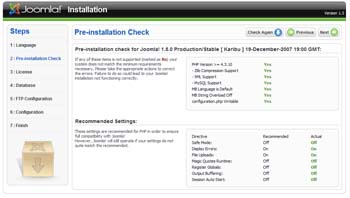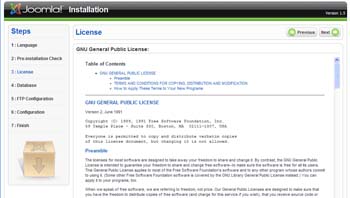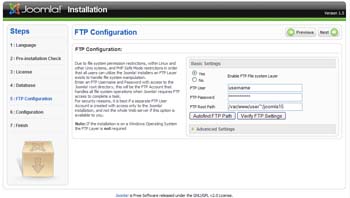Difference between revisions of "Installer"
From Joomla! Documentation
| Line 35: | Line 35: | ||
'''Recommended settings:''' | '''Recommended settings:''' | ||
| − | *Safe Mode is off | + | *Safe Mode is off in the actual column |
| − | *Display Errors is on | + | *Display Errors is on in the actual column |
| − | *File Uploads is on | + | *File Uploads is on in the actual column |
| − | *Magic Quotes Runtime is off | + | *Magic Quotes Runtime is off in the actual column |
| − | *Register Globals is off | + | *Register Globals is off in the actual column |
| − | *Output Buffering is off | + | *Output Buffering is off in the actual column |
| − | *Session Auto Start is off | + | *Session Auto Start is off in the actual column |
Revision as of 04:48, 15 January 2009
This page has been archived. This page contains information for an unsupported Joomla! version or is no longer relevant. It exists only as a historical reference, it will not be improved and its content may be incomplete and/or contain broken links.
This page is tagged because it NEEDS REVIEW. You can help the Joomla! Documentation Wiki by contributing to it.
More pages that need help similar to this one are here. NOTE-If you feel the need is satistified, please remove this notice.
Using the the Joomla! Installer[edit]
Once your files have been uploaded to the hosting space using an FTP client, it is time to install Joomla!.
First open an Internet Browser and type in the address of your Joomla! installation directory. For example:
yourdomain.com/joomlainstallationdirectoryor if you are running from your local server, type:
http://localhost/name of your joomla site/installation/index.php
Screen 1:
After the correct address is entered, the image below will appear. Joomla! has redirected you to the /installation subdirectory. In this step you can choose the default language (English) or anyother one.
Screen 2:
Click 'Next' and Joomla! displays the Pre-Installation Checklist. Specific details relating to PHP settings are outlined here. To proceed with the installation, all the lights should be green and set to Yes.
Explanation about terms: (TECHNICAL REVIEW NEEDED OF THIS EXPLANATION)
- PHP version must be 4.3.10 or greater than 4.3.10
- Your webserver's PHP version must be over 4.3.10
- Zlib Compression Support
- XML support
- MySQL support
- MB Language is Default
- MB String Overload Off
- Writable configuration.php
- Create a file named configuration.php on root or rename the default one from the package(configuration.php-dist)
Recommended settings:
- Safe Mode is off in the actual column
- Display Errors is on in the actual column
- File Uploads is on in the actual column
- Magic Quotes Runtime is off in the actual column
- Register Globals is off in the actual column
- Output Buffering is off in the actual column
- Session Auto Start is off in the actual column
Screen 3:
Click 'Next' and the licence prompt below will appear.GNU/GPL
Screen 4:
Click 'Next' to enter the Database specifics. Guidelines are provided on the right-hand side to assist in completing the text fields properly. Please note that all data must be entered correctly to avoid errors.
Screen 5:
Click 'Next' to enter the FTP settings. This allows Joomla! to operate in a more secure way, eliminating the need for PHP to handle file upload requests. Note: The FTP layer is not necessary on Windows servers.
Screen 6:
Click 'Next' to enter the Main Configuration details.
Screen 7:
Click 'Next' and a warning to delete the installation directory will appear. Once that is done (most likely using FTP client, click either the 'View Site' tab or the 'Administrator' tab to continue using Joomla!.




